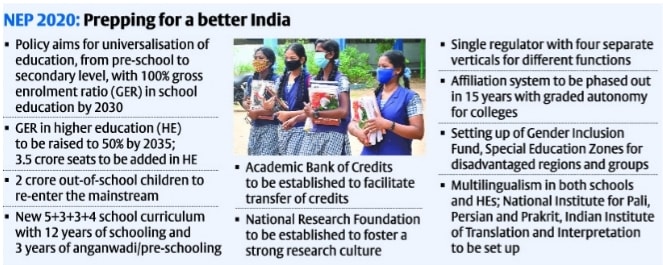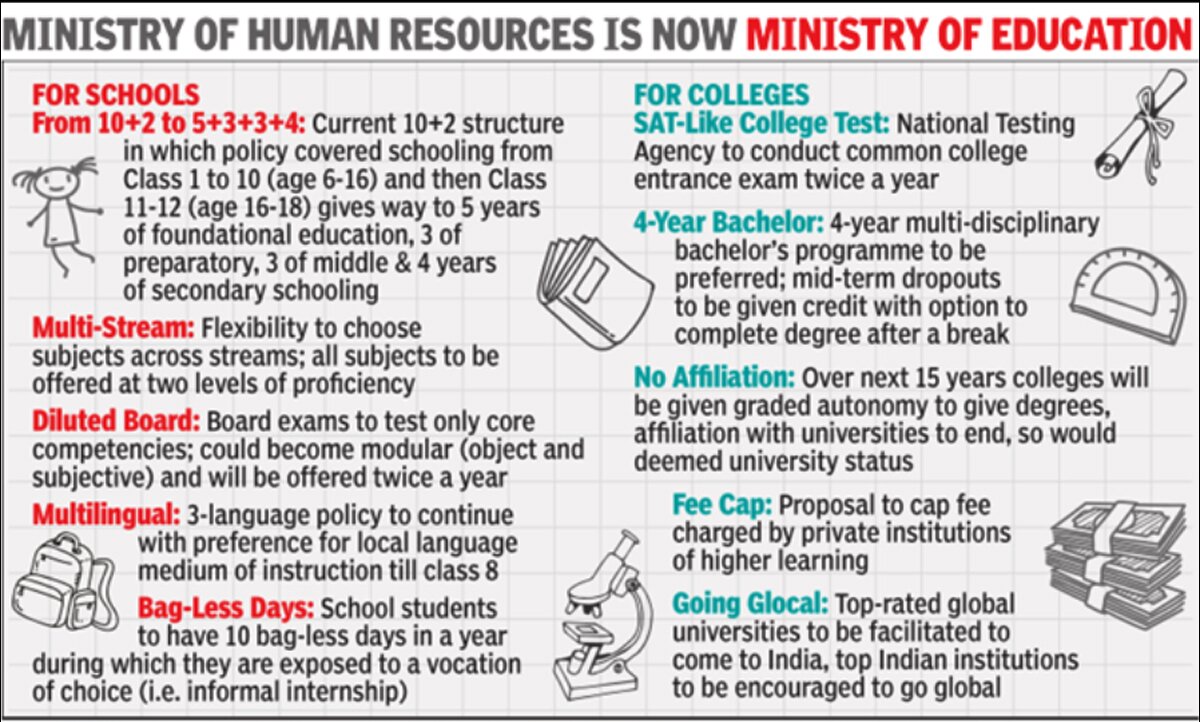Significance of National Education Policy 2020 GS Paper 2 Education; Issues related to development
#IAS #RAS #NDA #CDS #UPSC #udaipur #mewar
- Recognising Importance of Formative years: In adopting a 5+3+3+4 model for school education starting at age 3, the policy recognises the primacy of the formative years from ages 3 to 8 in shaping the child’s future.
- Departure from Silos Mentality: Another key aspect of school education in the new policy is the breaking of the strict division of arts, commerce and science streams in high school.
- This can lay the foundation for a multi-disciplinary approach in high education.
- The Confluence of Education and Skills: Another laudable aspect of the scheme is the introduction of vocational courses with an internship. This may nudge the vulnerable sections of society to send their children to school.
- Also, it would help in realisation of the goal of Skill India Mission.
- Making Education More Inclusive: The NEP proposes the extension of the Right to Education (RTE) to all children up to the age of 18.
- Further, the policy seeks to leverage the huge potential of online pedagogy and learning methodologies for increasing gross enrolment in higher education.
- Light But Tight Oversight: According to the policy, in spite of periodic inspection, transparency, maintaining quality standards and a favourable public perception will become a 24X7 pursuit for the institutions, leading to all-round improvement in their standard.
- The policy also seeks to establish a super-regulator for education which will be responsible for standards-setting, funding, accreditation and regulation of higher education India.
- Allowing Foreign Universities: The document states universities from among the top 100 in the world will be able to set up campuses in India.
- This will lead to an infusion of international perspective and innovation, which will make the Indian education system more efficient and competitive.
- Ending Hindi vs English Debate: Most crucially, NEP, once and for all, buries the strident Hindi versus English language debate; instead, it emphasises on making mother tongue, local language or the regional language the medium of instruction at least till Grade 5, which is considered the best medium of teaching.

Issues Related to NEP 2020
- Knowledge-Jobs Mismatch: There is a persistent mismatch between the knowledge & skills imparted and the jobs available. This has been one of the main challenges that have affected the Indian education system since Independence.
- NEP 2020 failed to check this, as it is silent on education related to emerging technological fields like artificial intelligence, cyberspace, nanotech, etc.
- The Requirement of Enormous Resources. An ambitious target of public spending at 6% of GDP has been set. Mobilising financial resources will be a big challenge, given the low tax-to-GDP ratio and competing claims on the national exchequer of healthcare, national security and other key sectors.

Way Forward
- Need For Cooperative Federalism: Since education is a concurrent subject (both the Centre and the state governments can make laws on it), the reforms proposed can only be implemented collaboratively by the Centre and the states.
- Thus, the Centre has the giant task of building a consensus on the many ambitious plans.
- Strive Towards Universalisation of Education: There is a need for the creation of ‘inclusion funds’ to help socially and educationally disadvantaged children pursue education.
- Also, there is a need to set up a regulatory process that can check profiteering from education in the form of unaccounted donations.
- Bridging Digital Divide: If technology is a force-multiplier, with unequal access it can also expand the gap between the haves and have nots.
- Thus, the state needs to address the striking disparities in access to digital tools for universalization of education.
- Interministerial Coordination: There is an emphasis on vocational training, but to make it effective, there has to be close coordination between the education, skills and labour ministry.

Conclusion
The new National Education Policy (NEP) 2020, is a good policy as it aims at making the education system holistic, flexible, multidisciplinary, aligned to the needs of the 21st century and the 2030 Sustainable Development Goals The intent of policy seems to be ideal in many ways but it is the implementation where lies the key to success.
|
Jinesh IAS Mains Question Discuss the salient features of National Education policy 2020 and how can it bring holistic changes in the Indian education system? |